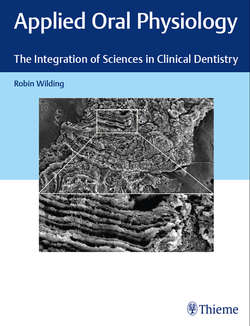Читать книгу Applied Oral Physiology - Robin Wilding - Страница 56
На сайте Литреса книга снята с продажи.
3.7 Junctional Epithelium
ОглавлениеThe junctional epithelium is an extension of the epithelium of the gingival sulcus but has some important differences. Firstly, unlike the epithelium of the gingival sulcus, it is physically attached to the surface of the tooth (▶ Fig. 3.12). Further, it is nonkeratinized, lacks the prominent rete ridges of gingival epithelium, and has no granular or keratin layer. The basal cells of the junctional epithelium are cuboidal and attached to the external basal lamina. The layer of epithelial cells above the basal lamina varies in thickness but is not more than about 20 cells thick. The unusual feature of junctional epithelium is that the surface cells are also attached to an internal basal lamina which in turn is attached to the enamel (or cementum) of the tooth. This attachment is achieved by hemidesmosomes at intervals along the basement membrane. This internal basement lamina is a product of the underlying cells and requires synthesis just as the synthesis of keratin would in the epithelium of attached gingiva.
The junctional epithelium forms a cuff of attachment around the tooth and is therefore of key importance as a barrier to the entrance of bacteria down the tooth surface and into the periodontium. We have seen the value of rapid turnover in epithelia, which allows regular shedding of the surface cells, along with any organisms that have obtained a foothold. The junctional epithelium exploits this process and turns over in just 4 to 6 days (in marmosets). The cells are not shed against the tooth surface but migrate through the layers above and emerge at the junction of the tooth and gingival sulcus. The junctional epithelium exploits other features of its structure to control the microorganism of dental plaque. The individual cells are not held close together (fewer desmosomes), and this allows neutrophil leukocytes to patrol in between the cells. Lymphocytes and monocytes may also occasionally be seen in the junctional epithelium. They are seen in much greater numbers if the gingiva becomes inflamed. Lastly, to help sweep away and disable microorganisms invading the junctional epithelium, a fluid exudate flows between the cells of the junctional epithelium and emerges into the gingival crevice (see Chapter 4.2.4 Gingival Crevicular Fluid).
Fig. 3.12 A diagrammatic representation of the junctional epithelium. The basal cells are attached to the external basement lamina (EBL) by hemidesmosomes. The inner basement lamina (IBL) forms the epithelial attachment to enamel, also via hemidesmosomes. The central cells of the epithelium are loosely attached and allow gingival fluid to flow outward into the gingival sulcus. C, cementum; D, dentin; E, enamel; l-break/>LP, lamina propria.
If the junctional epithelium is surgically removed, a new junctional epithelium forms and attaches to the tooth. It is presumably derived from the epithelium of the sulcus.
